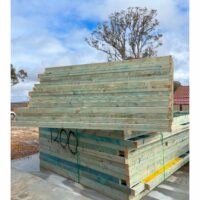After receiving timber products from fabricators, it is important to look after them and ensure they are fit for their original purpose.
One of biggest problems for exposed timber framing is repeated wetting and drying events caused by rain, plumbing leaks or ponding issues. Humidity and condensation in a roof space can lead to a phenomenon called mechano-sorptive effects which impact the strength and reliability of roof trusses (particularly unsarked tiled roofs).

Nailplate backout is another issue often identified during an investigation, most related to moisture ingress. This issue can cause reduced load carrying capacity of the joints which can be upwards of 30% reduction even at 1mm back out. Remember that hammering the nailplate back into place may not always solve the problem!
Here are some guidelines on protecting timber materials onsite by Pryda Design Services Engineer Nick Cui.
- Install roof lining
Installing roof lining as quickly as possible. Providing the correct protection under wall bottom plates can also help prevent moisture damage. Similarly, getting the walls and building envelope sealed with sarking or suitable membrane adds the second level of protection for walls and floors. - Be aware of exposure periods
The rule of thumb is that 2-3 months is generally OK. Upwards of 6 to 7 months is where you might start to expect issues arising such as discoloration, minor nailplate issues, dimensional variations where an inspection is recommended. Beyond 7 months is usually a red flag where we highly recommend an investigation be undertaken.
Implementing protective measures as quickly as possible is the best way to minimise issues and prevent them adding up when it comes time to rectify the job.
The FTMA (Frame and Truss Manufacturers Association) has developed a handy cheat sheet on caring for timber products.
